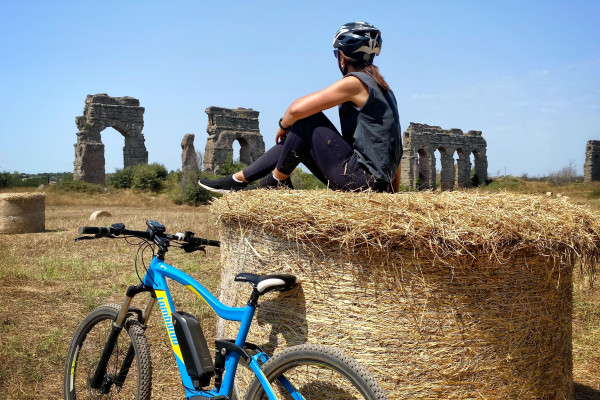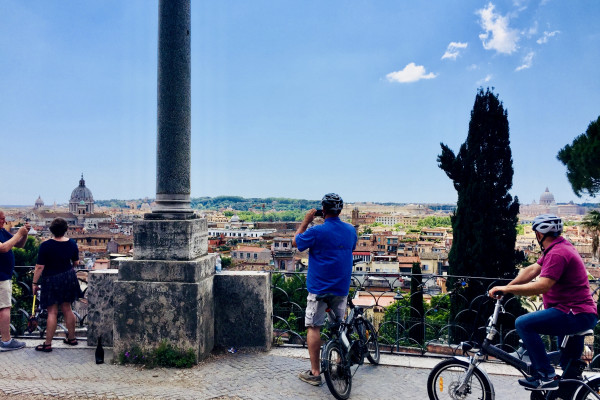Exploring Rome's charming Parks on an Electric Bike Adventure

Ranked among Europe’s most verdant cities, Rome proudly showcases extensive parklands and villa areas. Embarking on an electric bike tour Rome allows you to explore each park thoroughly. Do you have a favorite among them?
Villa Borghese
Spacious, elegant, and adorned with shaded clearings and beautiful fountains, Villa Borghese is an ideal park for a leisurely stroll or a picnic. Visitors can rent a boat for the small artificial lake within or opt for bicycles, scooters, or rollerblades. The park also houses the delightful municipal playhouse for children (Casina Raffaello), a puppet theater (San Carlino), and a cinema dedicated to kids (Cinema dei Piccoli). Notable features include a water clock, busts of various dignitaries, and an Egyptian-style obelisk erected by Emperor Hadrian on his beloved Antinous’s tomb. The Pincio Terrace within offers the most famous sunset panorama in Rome.
Read about the most panoramic views of Rome!
Villa Celimontana
Located atop the Celio hill southeast of Rome, Villa Celimontana’s main entrance is near Piazza della Navicella, adjacent to the Basilica of Santa Maria in Domnica. This park, an extension of the Baths of Caracalla, has a tradition of picnics since 1552. In summer, enchanting dinner-concerts take place as part of the “Village Villa Celimontana,” featuring jazz and swing concerts, street food, and ethnic cuisine.
Villa Doria Pamphilj
As the largest green area in Rome (184 hectares), Villa Doria Pamphilj stretches from the Gianicolo along the ancient Via Aurelia. Perfect for running, walking, or enjoying exercise stations, it features a small lake and hills adorned with villas, fountains, lakes, and orange groves, creating an ideal setting for strolls or picnics under maritime pines.
Giardino degli Aranci
Commonly referred to in Rome as the Parco Savello, this small park on the Aventine Hill offers an excellent city view from above. Designed in 1932 by Raffaele De Vico, the garden is home to bitter orange trees and sits on the site of an ancient fortress built near the Basilica of Santa Sabina. The garden features remnants of the Savelli castle wall and an Egyptian-style obelisk.
Orto Botanico
Located at Largo Cristina di Svezia, 23A, the charming botanical gardens and grounds of the Corsini Gallery provide a delightful space to spend an hour or two surrounded by the fragrant air of over 7,000 plant species. Owned by the University of Rome, the gardens include native and exotic varieties, organized by ecosystems. Admission is 4 euros.
Villa Sciarra
Situated on the Gianicolo, in the Trastevere district, Villa Sciarra takes its name from a branch of the Colonna family, the Colonna di Sciarra, who owned it in the 18th and 19th centuries. The Villa then passed to the Wurts family, who enriched it with sandstone statues from the Visconti castle of Brignano d’Adda, eventually gifting it to the fascist government along with a substantial sum for maintenance expenses.
The vast 7.5-hectare park of Villa Sciarra leans against the west and south walls of the Gianicolo (Mura Gianicolensi), constructed in 1643 by Pope Urban VIII. To the east, Via Dandolo, and to the north, Via Calandrelli, provide access from the city center. Via Calandrelli leads to Piazzale Wurts, the monumental entrance designed by architect Pio Piacentini (1846-1928).
Villa Ada
Originally King Vittorio Emanuele III’s hunting reserve, this massive public park at Via Salaria 265 features undulating meadows, serene waters, and deciduous woods. A perfect escape from the city’s hustle and bustle, the park hosts food stalls and concerts at the northern end of its lake on summer nights.
Parco del Colle Oppio
Offering arguably the world’s most beautiful view of the Colosseum, the Parco del Colle Oppio becomes a welcome sight after hours of walking around the Forum and Colosseum in the summer heat. Most of the park is, in fact, the roof of Nero’s Domus Aurea, and visitors can observe skylights for its rooms. For those not weary of sightseeing, massive remains of the Trajan’s Baths are scattered in the area.
Parco della Caffarella
Adjacent to the Aurelian Walls and situated between two ancient thoroughfares, Via Latina and Via Appia, this vast park combines farmland and wilderness with abundant wildlife, dotted with the remains of Roman temples. A large children’s playground is also available.
Parco degli Acquedotti
One of Rome’s hidden treasures, the Parco degli Acquedotti is a fascinating destination for lovers of ancient history and nature. Located in the Appio Claudio district, southeast of the historic center, the park is easily accessible and offers a series of trails allowing visitors to explore ancient Roman aqueducts up close. These walks provide panoramic views of arches and ruins, offering a unique opportunity to immerse oneself in both history and nature.
For sports enthusiasts, the park provides free-standing exercise equipment and designated paths. Frequented by athletes and nature lovers at all hours of the day, it serves as a fantastic space for both recreation and historical exploration.
In conclusion, Rome’s abundance of green spaces provides a diverse range of experiences, from leisurely strolls and picnics to cultural events and historical exploration. Each park mentioned offers a unique blend of natural beauty, historical significance, and recreational opportunities, making them integral parts of Rome’s vibrant tapestry. Whether seeking tranquility, panoramic views, or active pursuits, these green oases contribute to Rome’s timeless allure as a city that seamlessly marries the ancient and the contemporary, inviting residents and visitors alike to connect with nature and history in a harmonious blend
Book With Extra Flexibility
Choose new departure dates if your plans change.
Reach out to us anytime via online chat, phone or email.
Get credit for future trips if you need more time to decide.
Change to a different tour run by the same tour operator.







